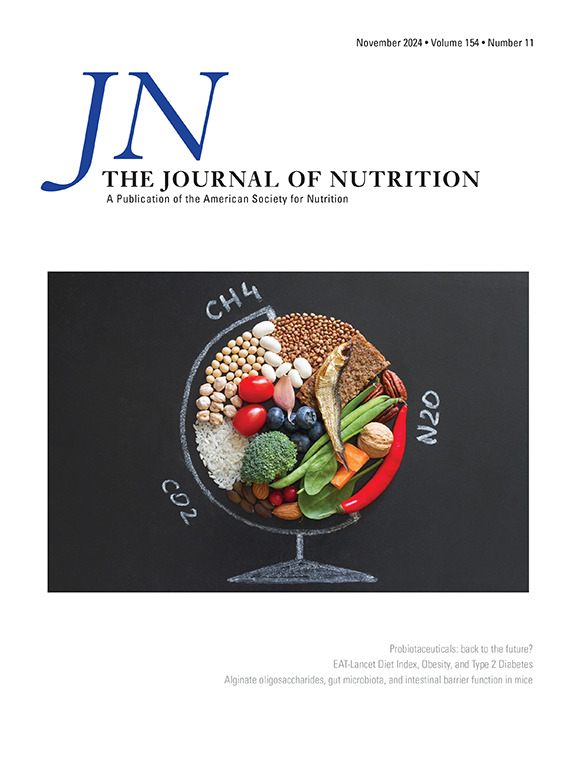健康成年人的微量膳食多酚摄入量与全身和胃肠道炎症有关。
IF 3.7
3区 医学
Q2 NUTRITION & DIETETICS
引用次数: 0
摘要
背景:多酚是一种膳食生物活性化合物,其中许多具有抗炎特性。然而,有关膳食多酚的类别和化合物摄入量及其与胃肠道(GI)和全身炎症的关系的信息还很缺乏:估计健康成年人的膳食多酚摄入量,并研究其与胃肠道和全身炎症指标的关系。方法:健康成年人(n = 350)完成美国农业部营养表型研究,这是一项观察性横断面研究,对年龄、性别和体重指数进行了平衡。膳食摄入量通过 24 小时多次回忆进行评估,并进行成分分析,然后映射到综合食物成分数据库 FooDB。采用线性模型和随机森林回归法估算膳食多酚摄入量(总摄入量、类别摄入量、化合物摄入量),并研究其与消化道和全身炎症指标的关系:多酚总摄入量的平均值约为每天 914 毫克/1000 千卡,其中类黄酮的摄入量最大(每天 495 毫克/1000 千卡)。茶、咖啡和水果是摄入多酚最多的食物。多酚总摄入量与消化道炎症标志物--粪便钙蛋白呈负相关(β=-0.004,p=0.04)。在类别水平上,多酚被归类为前醇脂类(β=-0.94,p=0.04):即使是健康成年人,膳食中多酚的摄入量也与消化道炎症呈负相关,而前酚类脂质和苯丙酸的摄入量与消化道通透性呈负相关。多酚摄入量与炎症结果之间的关系随多酚摄入量的分辨率(总量、类别、化合物)的不同而变化,这表明多酚对消化道和全身炎症的影响存在细微差别:临床试验登记:NCT02367287,ClinicalTrials.gov.本文章由计算机程序翻译,如有差异,请以英文原文为准。
Fine-Scale Dietary Polyphenol Intake Is Associated with Systemic and Gastrointestinal Inflammation in Healthy Adults
Background
Polyphenols are dietary bioactive compounds, many of which have anti-inflammatory properties. However, information on the intake of dietary polyphenols at the class and compound levels and their associations with gastrointestinal (GI) and systemic inflammation is lacking.
Objectives
Estimate dietary polyphenol intake in healthy adults and examine its relationship with GI and systemic inflammation markers.
Methods
Healthy adults (n = 350) completed the United States Department of Agriculture Nutritional Phenotyping Study, an observational, cross-sectional study balanced for age, sex, and body mass index. Dietary intake, assessed via multiple 24-h recalls, was ingredientized and mapped to FooDB, a comprehensive food composition database. Dietary polyphenol intake (total, class, compound) was estimated and examined for its relationship to GI and systemic inflammation markers using linear models and random forest regressions.
Results
Mean total polyphenol intake was ∼914 mg/1000 kcal/d with flavonoids as the greatest class contributor (495 mg/1000 kcal/d). Tea, coffee, and fruits were among the largest food contributors to polyphenol intake. Total polyphenol intake was negatively associated with the GI inflammation marker, fecal calprotectin (β = −0.004, P = 0.04). At the class level, polyphenols categorized as prenol lipids (β = −0.94, P < 0.01) and phenylpropanoic acids (β = −0.92, P < 0.01) were negatively associated with plasma lipopolysaccharide-binding protein, a proxy for GI permeability. Food sources of these two classes included mainly olive products. We further detected a positive association between C-reactive protein and polyphenols in the “cinnamic acids and derivatives” class using hierarchical feature engineering and random forest modeling.
Conclusions
Even in healthy adults, dietary polyphenol intake was negatively associated with GI inflammation and intake of prenol lipids and phenylpropanoic acids was negatively associated with GI permeability. Relationships between polyphenol intake and inflammatory outcomes varied with the resolution—total, class, compound—of polyphenol intake, suggesting a nuanced impact of polyphenols on GI and systemic inflammation.
This trial was registered at clinicaltrials.gov as NCT02367287.
求助全文
通过发布文献求助,成功后即可免费获取论文全文。
去求助
来源期刊

Journal of Nutrition
医学-营养学
CiteScore
7.60
自引率
4.80%
发文量
260
审稿时长
39 days
期刊介绍:
The Journal of Nutrition (JN/J Nutr) publishes peer-reviewed original research papers covering all aspects of experimental nutrition in humans and other animal species; special articles such as reviews and biographies of prominent nutrition scientists; and issues, opinions, and commentaries on controversial issues in nutrition. Supplements are frequently published to provide extended discussion of topics of special interest.
 求助内容:
求助内容: 应助结果提醒方式:
应助结果提醒方式:


